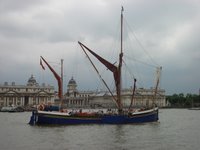River Thames



Tara on Tour
"I do not know much about gods; but I think that the river
Is a strong brown god - sullen, untamed and intractable.
Patient to some degree, at first recognised as a frontier;
Useful, untrustworthy, as a conveyor of commerce;
Then only a problem confronting the builder of bridges.
The problem once solved, the brown god is almost forgotten
By the dwellers in cities - ever, however, implacable. Keeping the seasons and rages, destroyer, reminder
Of what men choose to forget. Unhonoured, unpropitiated
By worshippers of the machine, but waiting, watching and waiting"
- T.S. Eliot: The Dry Salvages -
Travelling by boat along the River Thames on a gentle summer's day, it's easy to be lulled into a false sense of security about this river - or any river. Eliot's words hint at the dark depths and murky pasts so many rivers conceal beneath their dappling, rippling waters.
And the River Thames is no exception. In the 18th Century, the Thames was one of the busiest waterways in the world, putting London at the centre of the huge, mercantile British Empire. It was during this time, however, that one of the worst river disasters in England took place when, in 1878, a crowded pleasure boat collided with another boat - killing 640 people. Before that, in what became known as the 'Great Stink' of 1858, sittings at the House of Commons in Westminster were abandoned due to the appaling stench rising from the polluted river waters. This incident propelled the city into a major engineering programme to tackle the sewage problem, and giant sewers were constructed on both sides of the river embankment under the supervision of Joseph Bazalgette.
We think of the Thames as a dirty river today, but in fact it is relatively clean. Not only have the sewage problems been largely resolved, but the tremendous hammering the river took during the days when London was a major world port are over: rail and road transportation have largely taken the place of rivers and even the old Port of London has been moved downstream out of the heart of the city to Tilbury.
Flooding has always been a feature of life on the Thames. But it wasn't until 1953 when over 300 people were drowned as the Thames experienced its worst flood ever that London set about trying to keep the water levels stable. Whilst most of the damage was to the estuary area, around Canvey Island, the absence of any flood defences to speak of at the time meant that London was suddenly on red alert. Attempts to construct a suitable flood defence began, but failed because of the number of huge commercial vessels going up and down the river; the openings in any flood barrier needed to be so wide that the project just wasn't feasible. However, as the commercial use of the river dwindled and after the Port of London moved downstream to Tilbury, it was conceivable to construct an effective defence. So in 1974 work began on what has become the world's largest movable flood defence - the Thames Barrier.
It took 10 years to complete and cost over £500 million, but it is a magnificent feat of water engineering and has even been described as the eighth wonder of the world.
I took a boat out from Greenwich to see it for myself. It's always a joy to be on the river, and gives a fascinating perspective of the city. Leaving Greenwich, the boat passed the Royal Naval College - now home to Trinity College of Music; the infamous Millenium Dome (bought by an American to be turned into a casino); London Docklands and then the Barrier itself. Nine great concrete piers stretch across the river; each one buried 50 ft below river level on solid chalk foundations and some weighing 1500 tonnes. It takes 40 minutes to turn the wheels to raise or lower the flood wall and at any given time, one or more stretches of the wall will be lowered. The Thames is most at risk from flooding due to tidal surges that happen out in the North Sea: these occasionally find their way into the estuary and result in sudden rises in water level. It's clear that the Thames Barrier has provided very good protection in recent years, but that further defences are needed for the future. Either strengthening of the existing ones, or very probably a new one out at the mouth of the Thames.
It's at the mouth of the Thames where the Third Tara will be placed....but first, there is a little more of Old Father Thames to be explored.

0 Comments:
Post a Comment
<< Home